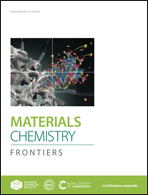Enhanced upconversion luminescence and optical thermometry in Er3+/Yb3+ heavily doped ZrO2 by stabilizing in the monoclinic phase†
Abstract
Er3+ and Yb3+ heavily doped monoclinic ZrO2 (m-ZrO2) stabilized by Nb5+ is prepared by solid-state reactions. The upconversion luminescence (UCL) of concentration optimized m-ZrO2:2%Er3+,9%Yb3+ shows a yellow emission which is found to be 4 times stronger than the red UCL of the optimized cubic ZrO2:2%Er3+,14%Yb3+. It is revealed that monoclinic ZrO2 has faster radiative transition rates of Er3+ and Yb3+ than cubic ZrO2 because of the lower crystal symmetry in the monoclinic phase that enables higher 4f–5d mixing of rare earth ions. The enhanced radiative transition allows 9%Yb3+ in the monoclinic phase to have a similar absorption of 980 nm excitation light to that of 14%Yb3+ in the cubic phase, thus retaining the lower energy back transfer from Er3+ in the green emitting state to Yb3+ and lower concentration quenching of Yb3+ in the monoclinic phase. The green and red dual-color optical thermometry behavior of m-ZrO2 has been explored. A large detectable temperature range, at which the absolute sensitivity is high, is realized through adopting this complementary optical thermometer. Repeated thermal experiments prove the stability of the m-ZrO2 as a temperature probe. Our results indicate that heavily doped m-ZrO2 is an excellent host for efficient luminescence of rare earth ions.



 Please wait while we load your content...
Please wait while we load your content...